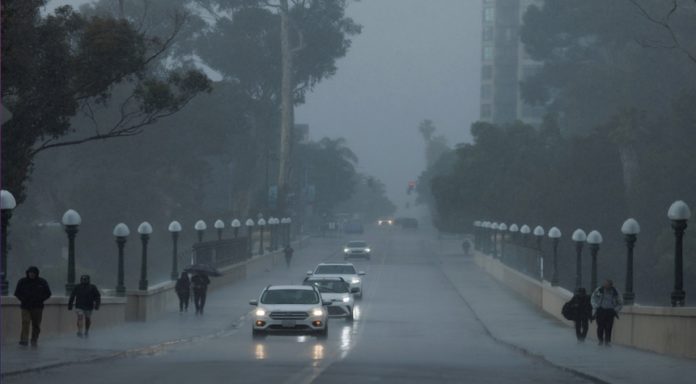Reports of severe storms and damaging winds are flooding parts of Oklahoma and Texas. They left a trail of destruction Tuesday morning and will continue to threaten more as blizzard conditions develop in several other states further north.
All this is part of a massive winter storm system that has pushed into the central US, after wreaking havoc on the West over the weekend. A total of 25 million people in Texas and Mississippi are at risk from severe storms, including tornadoes, Tuesday. About 15 million people, mainly in the north-central US, are under winter weather advisories or warnings Tuesday morning. Power outages are a major concern.
Two tornado watches are in place: one for parts of Dallas and southern Oklahoma, until 11 a.m. CST; one for parts of Arkansas, southeastern Oklahoma, and eastern Texas, until 5 p.m. CST.
In the middle of the morning, a line of severe thunderstorms capable of producing tornadoes or large hail hit the Dallas/Fort Worth metroplex.
Around 9:30 a.m., sirens rang out. ET at Dallas Fort-Worth International Airport. “We are currently in the midst of a tornado warning here at the Dallas-Fort Worth region,” CNN’s Ed Lavandera stated from the airport “essentially everything has stopped here (as this really strong line of severe storms is making its way through North Texas).”
Tuesday Morning Damage Includes:
* Wayne, Oklahoma: The tornado that struck the town on Tuesday morning left buildings “wiped off their foundations (and) trees snapped like twigs,” CNN meteorologist Derek Van Dam stated. According to McClain County emergency management, there are no injuries. Wayne does not have power and structures such as barns, outbuildings, or family structures are also damaged.
* Outside Dallas: Wind damage was reported Tuesday morning west of the Dallas/Fort Worth Metroplex. This included tractor-trailers being blown away near the towns of Decatur and Millsap, as well as barns that sustained damage near Jacksboro.
As the complex snow-or-rain system sweeps across the central US, more severe storms capable of producing tornadoes are possible Tuesday and Wednesday in the Gulf Coast area.
Blowing snow or freezing rain could cause delays in travel across the Upper Midwest and Northern Plains, and may even threaten power outages on Thursday.
These Are The Future Prospects For Different Regions:
* Tuesday’s severe storms pose an “enhanced threat” in eastern Texas, northern Louisiana, and southwestern Mississippi. There are tornadoes, large hail, and potentially damaging straight-line winds.
* Blizzard conditions are possible Tuesday and Wednesday in parts of the central Plains. Snowfall rates of up to 1 to 2 inches per hour are expected amid strong winds of 40 mph.
* Flash flooding is most likely Tuesday and Wednesday, from the lower Mississippi Valley to the central Gulf Coast, Tennessee Valley, and the southern Appalachians.
* The Upper Midwest will see freezing rain and snow through Wednesday.
Blizzard Warnings And Ice Warnings For The Central US
The storm that first struck the Western US with snow and rain brought about winter storm alerts, starting at the border of Canada with Mexico.
Denver is expected to get up to 5 inches of snow Tuesday with wind gusts of 50 mph.
Blizzard warnings were extended Tuesday to parts of Montana, Wyoming, and northeastern Colorado. They also reached western Nebraska, South Dakota, and northern Nebraska.
On Wednesday morning, snowfall could average between 10 and 18 inches across the Upper Midwest and central Plains. The Weather Prediction Center stated that some areas within the blizzard warning zone — including western South Dakota, eastern Wyoming, and northwestern Nebraska — could see as much as 24 inches of snow. Winds strong enough to cause power outages and knock down trees, and winds as strong as those in the Weather Prediction Center.
Brandon Wills, a meteorologist with the National Weather Service, in Cheyenne, Wyoming said Monday night that “we’re not expecting to see a sudden burst” of snowfall. He said that snow will “accumulate the most in the northern Nebraska Panhandle — and it will be blowing around like mad because of the strong winds we’re going through as well.”
The blizzard conditions could make it impossible to travel on Interstates in South Dakota, according to the South Dakota Department of Transportation Monday.
Warnings of ice storms were issued in parts of eastern South Dakota and western Iowa. Forecasters warned that up to two-tenths inch of ice could build up in these areas.
Anchorage, Alaska: Due to an “unprecedented” amount of snowfall, schools were closed for four days. On Monday, the University of Alaska Anchorage was shut down as well as Alaska Pacific University.
Hans Rodvik, a spokesperson for Anchorage’s mayor, stated Monday that the snowstorms that hit Anchorage in the past week were historic and brought anywhere from 30-45 inches of snow.
Tornadoes Are A Danger At The Storm’s Southern Tip
The southern end of the storm is threatening to bring about tornadoes.
Up to 11 AM CT, a tornado watch will be in effect for parts of Texas as well as southern Oklahoma on Tuesday morning. Tornadoes, hail, and winds gusts of up to 70 mph are the main threats.
Tuesday’s alert was for eastern Texas and the lower Mississippi River Valley. The main threats include powerful tornadoes and damaging winds as well as large hail. Baton Rouge and Shreveport, Louisiana, along with Jackson, Mississippi, are all part of the area in danger.
Chad Myers, a CNN meteorologist, stated Tuesday that “my main concern about the tornadoes will be after dark.” “We have very few days this time of the year, so it will be dark out there at 5 or 6 o’clock. When it’s dark, spotters don’t work as well. Tornado warnings can be slow. If you are asleep, they may not reach you. This is the main danger of this storm.
The area is enclosed by a zone of moderate risk, level 2 of 5, which extends from southern Oklahoma and eastern Texas to southern Arkansas. It also includes much of central Mississippi and Louisiana. This includes New Orleans and Dallas.
The Weather Prediction Center stated Tuesday’s possible excessive rainfall risk in Arkansas, Louisiana, and Mississippi. This could lead to flash flooding and 2 to 4 inches of rain.
According to the Storm Prediction Center, severe weather threats are mainly focused on Wednesday with tornadoes and destructive winds possible over areas of the Gulf Coast.




